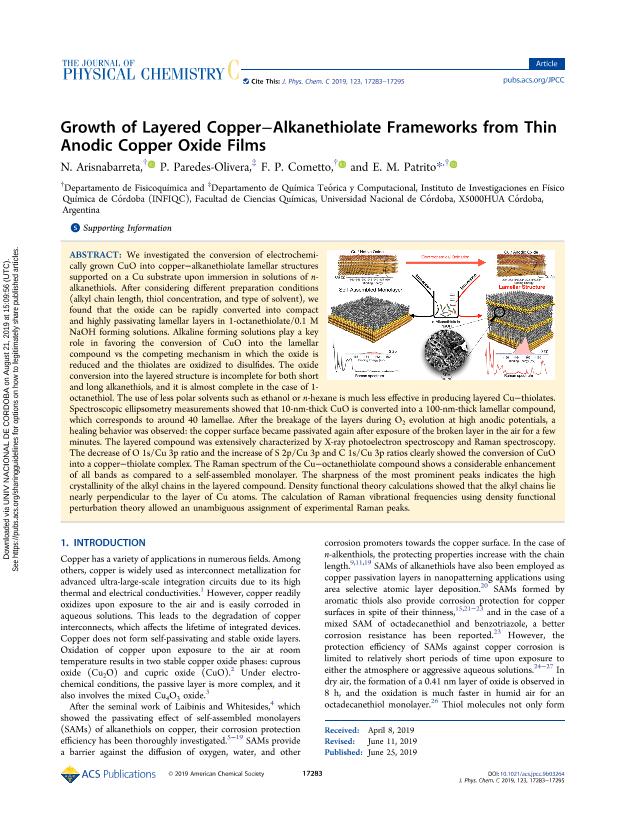Mostrar el registro sencillo del ítem
dc.contributor.author
Arisnabarreta, Nicolás

dc.contributor.author
Paredes Olivera, Patricia

dc.contributor.author
Cometto, Fernando Pablo

dc.contributor.author
Patrito, Eduardo Martin

dc.date.available
2021-02-02T19:05:27Z
dc.date.issued
2019-06
dc.identifier.citation
Arisnabarreta, Nicolás; Paredes Olivera, Patricia; Cometto, Fernando Pablo; Patrito, Eduardo Martin; Growth of Layered Copper-Alkanethiolate Frameworks from Thin Anodic Copper Oxide Films; American Chemical Society; Journal of Physical Chemistry C; 123; 28; 6-2019; 17283-17295
dc.identifier.issn
1932-7447
dc.identifier.uri
http://hdl.handle.net/11336/124514
dc.description.abstract
We investigated the conversion of electrochemically grown CuO into copper-alkanethiolate lamellar structures supported on a Cu substrate upon immersion in solutions of n-alkanethiols. After considering different preparation conditions (alkyl chain length, thiol concentration, and type of solvent), we found that the oxide can be rapidly converted into compact and highly passivating lamellar layers in 1-octanethiolate/0.1 M NaOH forming solutions. Alkaline forming solutions play a key role in favoring the conversion of CuO into the lamellar compound vs the competing mechanism in which the oxide is reduced and the thiolates are oxidized to disulfides. The oxide conversion into the layered structure is incomplete for both short and long alkanethiols, and it is almost complete in the case of 1-octanethiol. The use of less polar solvents such as ethanol or n-hexane is much less effective in producing layered Cu-thiolates. Spectroscopic ellipsometry measurements showed that 10-nm-thick CuO is converted into a 100-nm-thick lamellar compound, which corresponds to around 40 lamellae. After the breakage of the layers during O2 evolution at high anodic potentials, a healing behavior was observed: The copper surface became passivated again after exposure of the broken layer in the air for a few minutes. The layered compound was extensively characterized by X-ray photoelectron spectroscopy and Raman spectroscopy. The decrease of O 1s/Cu 3p ratio and the increase of S 2p/Cu 3p and C 1s/Cu 3p ratios clearly showed the conversion of CuO into a copper-thiolate complex. The Raman spectrum of the Cu-octanethiolate compound shows a considerable enhancement of all bands as compared to a self-assembled monolayer. The sharpness of the most prominent peaks indicates the high crystallinity of the alkyl chains in the layered compound. Density functional theory calculations showed that the alkyl chains lie nearly perpendicular to the layer of Cu atoms. The calculation of Raman vibrational frequencies using density functional perturbation theory allowed an unambiguous assignment of experimental Raman peaks.
dc.format
application/pdf
dc.language.iso
eng
dc.publisher
American Chemical Society

dc.rights
info:eu-repo/semantics/openAccess
dc.rights.uri
https://creativecommons.org/licenses/by-nc-sa/2.5/ar/
dc.subject
ALKANETHIOLS
dc.subject
CU
dc.subject
LAMELLAR STRUCTURES
dc.subject
ELECTROCHEMISTRY
dc.subject.classification
Físico-Química, Ciencia de los Polímeros, Electroquímica

dc.subject.classification
Ciencias Químicas

dc.subject.classification
CIENCIAS NATURALES Y EXACTAS

dc.title
Growth of Layered Copper-Alkanethiolate Frameworks from Thin Anodic Copper Oxide Films
dc.type
info:eu-repo/semantics/article
dc.type
info:ar-repo/semantics/artículo
dc.type
info:eu-repo/semantics/publishedVersion
dc.date.updated
2020-11-17T18:36:03Z
dc.journal.volume
123
dc.journal.number
28
dc.journal.pagination
17283-17295
dc.journal.pais
Estados Unidos

dc.description.fil
Fil: Arisnabarreta, Nicolás. Consejo Nacional de Investigaciones Científicas y Técnicas. Centro Científico Tecnológico Conicet - Córdoba. Instituto de Investigaciones en Físico-química de Córdoba. Universidad Nacional de Córdoba. Facultad de Ciencias Químicas. Instituto de Investigaciones en Físico-química de Córdoba; Argentina
dc.description.fil
Fil: Paredes Olivera, Patricia. Consejo Nacional de Investigaciones Científicas y Técnicas. Centro Científico Tecnológico Conicet - Córdoba. Instituto de Investigaciones en Físico-química de Córdoba. Universidad Nacional de Córdoba. Facultad de Ciencias Químicas. Instituto de Investigaciones en Físico-química de Córdoba; Argentina
dc.description.fil
Fil: Cometto, Fernando Pablo. Consejo Nacional de Investigaciones Científicas y Técnicas. Centro Científico Tecnológico Conicet - Córdoba. Instituto de Investigaciones en Físico-química de Córdoba. Universidad Nacional de Córdoba. Facultad de Ciencias Químicas. Instituto de Investigaciones en Físico-química de Córdoba; Argentina
dc.description.fil
Fil: Patrito, Eduardo Martin. Consejo Nacional de Investigaciones Científicas y Técnicas. Centro Científico Tecnológico Conicet - Córdoba. Instituto de Investigaciones en Físico-química de Córdoba. Universidad Nacional de Córdoba. Facultad de Ciencias Químicas. Instituto de Investigaciones en Físico-química de Córdoba; Argentina
dc.journal.title
Journal of Physical Chemistry C

dc.relation.alternativeid
info:eu-repo/semantics/altIdentifier/doi/http://dx.doi.org/10.1021/acs.jpcc.9b03264
dc.relation.alternativeid
info:eu-repo/semantics/altIdentifier/url/https://pubs.acs.org/doi/10.1021/acs.jpcc.9b03264
Archivos asociados
